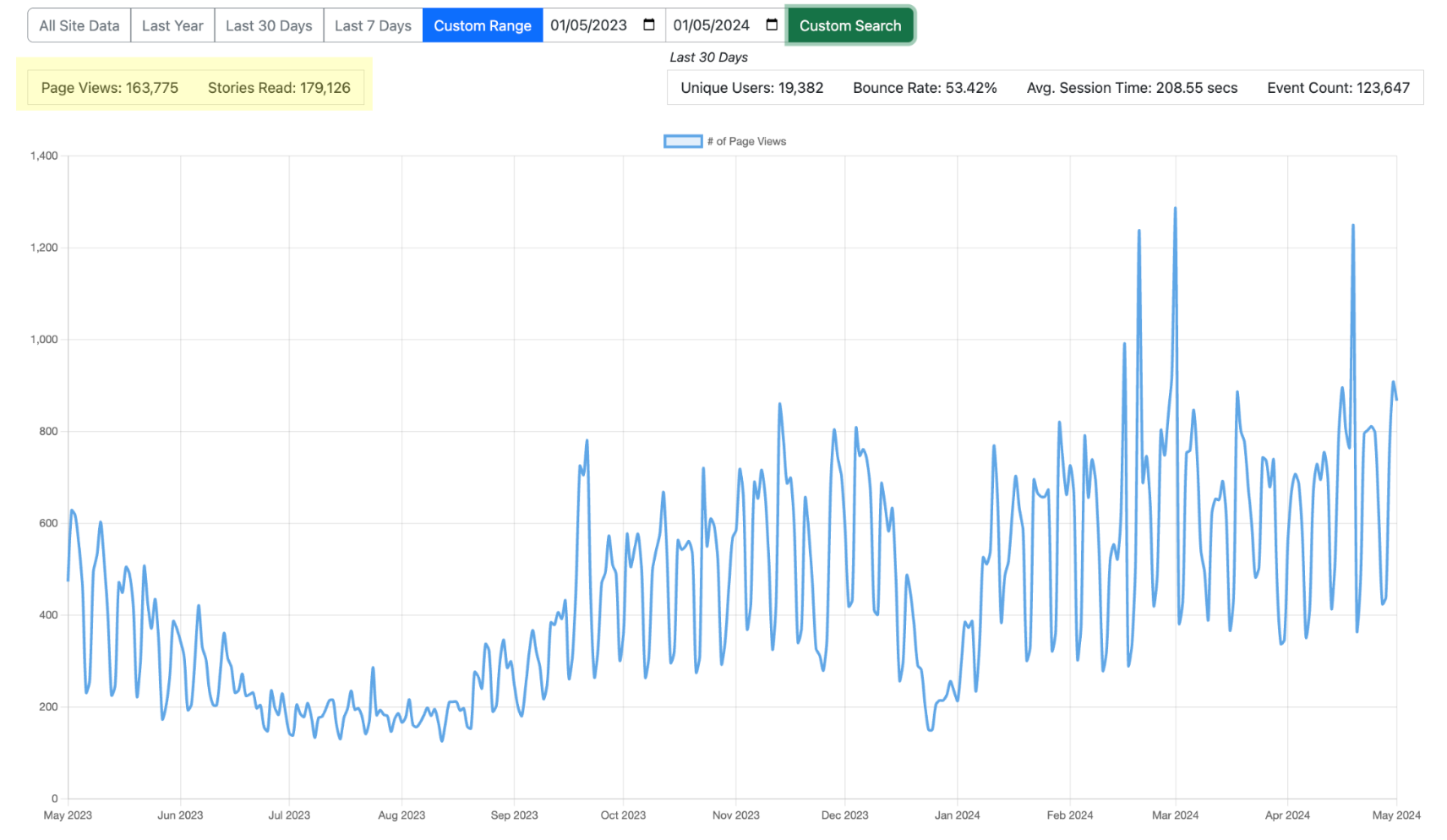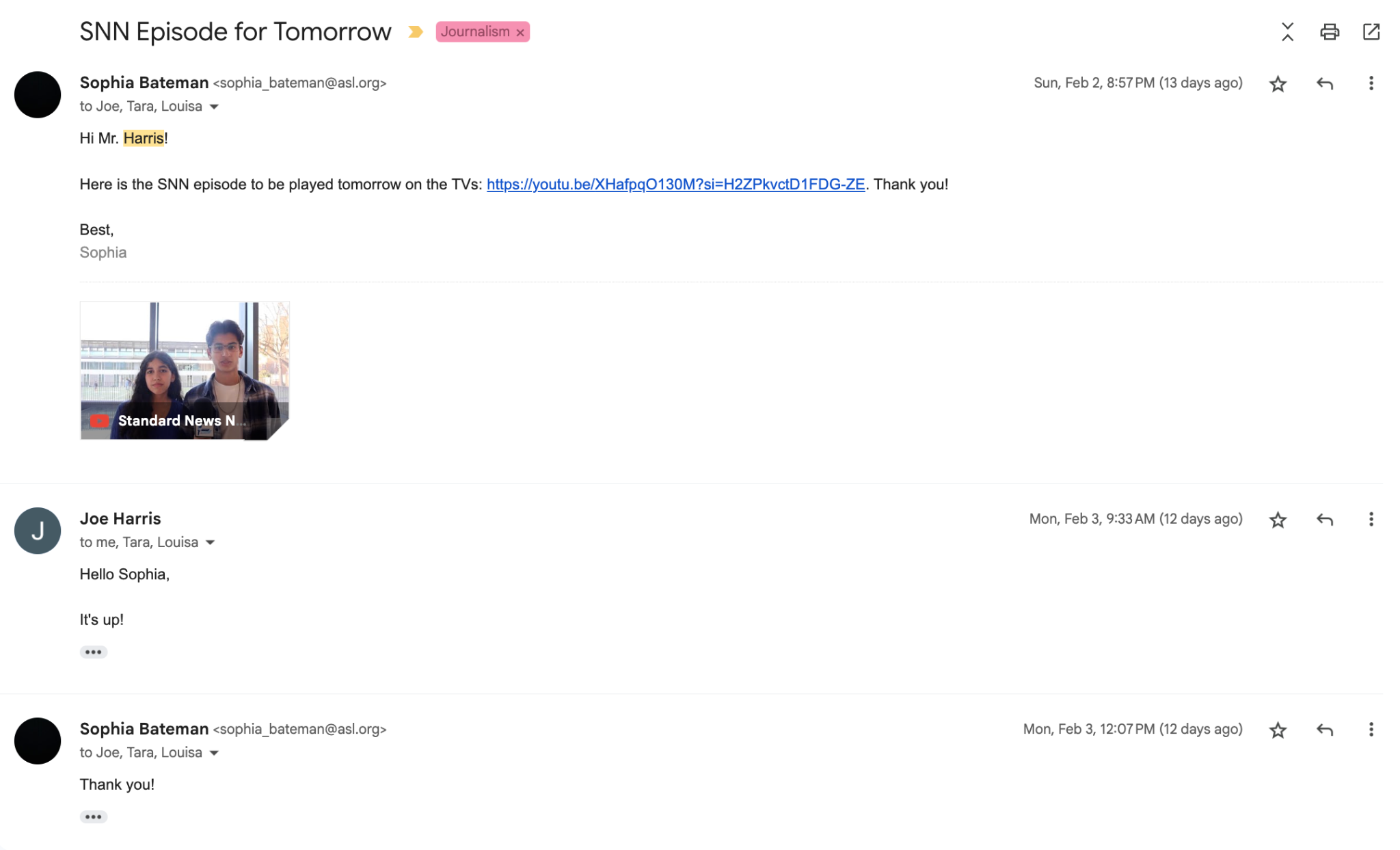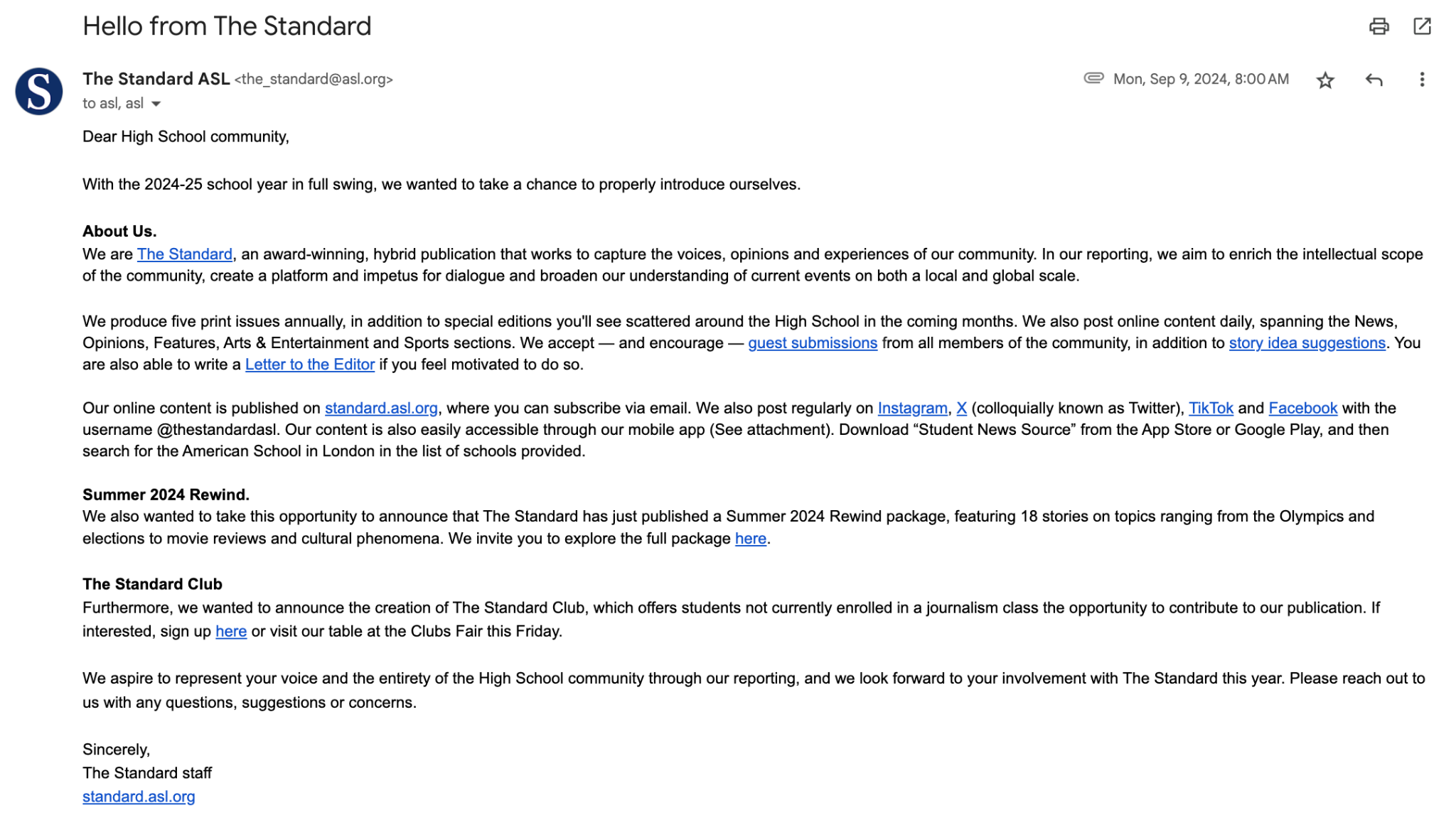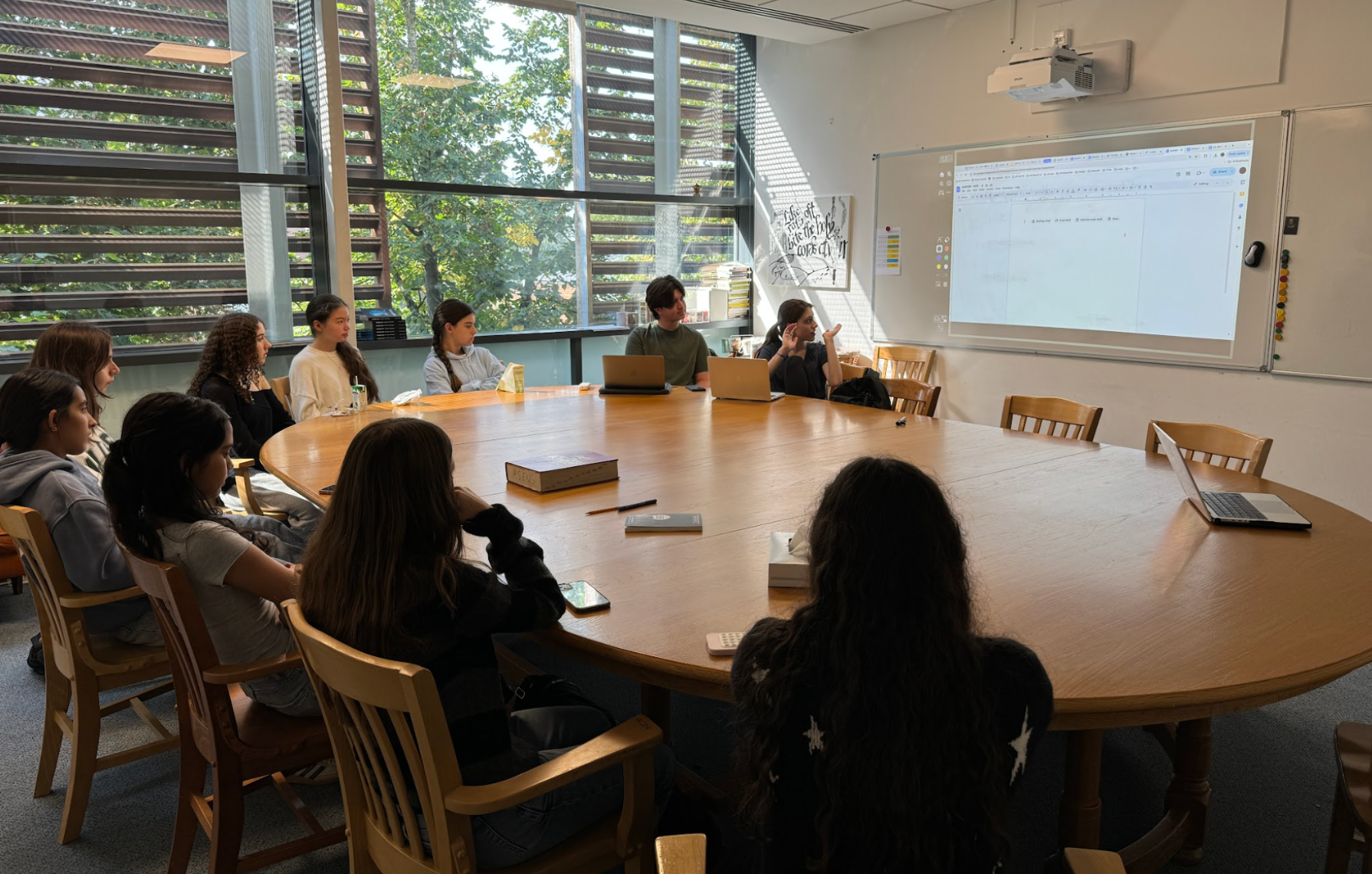

I pose a question to Executive Chairman of Sky News Group David Rhodes, London School of Economics Professor Chris Anderson, and Meta VP for Europe, Middle East and Africa Derya Matras during a Speaker Series panel on misinformation and elections at my school Oct. 22, 2024.
As part of my role, I track our website analytics multiple times a week to identify trends and guide our marketing efforts. This helps us understand what content resonates and when engagement peaks — for instance, we consistently see spikes in traffic whenever we publish an online package, driven by our targeted promotion through email and social media.
Comparing analytics from May 2023–May 2024 and May 2024–present — the respective terms of the 2023-24 and 2024-25 Editorial Boards — demonstrates clear growth. Despite covering fewer months, this year we’ve already seen over 50,000 more page views and over 60,000 more stories read, reflecting our increased focus on digital content and strategic audience engagement. Please note that, due to this increase, the graph scales are different.
2023-24 analytics:
2024-25 analytics:
In addition, so far this year we’ve earned 29 Best of SNOs awards — surpassing the individual total from each of the past two years, which were 22 and 24. Given the high traffic the Best of SNO website receives, I believe this recognition has played a key role in driving more readers to our site and contributing to our increased website analytics.
I regularly monitor our social media accounts and analytics to track engagement, assess what types of content perform best and identify areas for improvement. This helps ensure our strategies remain effective and allows us to adjust in real time to maximize reach and audience interaction. Hover over the image below to read detailed descriptions of how I utilize our Instagram account's analytics.

To direct more viewers to our site, we publish "social media blurbs" on our Facebook, X and Bluesky accounts that tease online stories. This is a required component that reporters must include when writing a story for our website.
Recognizing Bluesky’s growing momentum in the latter half of 2024, I took the initiative to create an account for The Standard, ensuring our publication had a presence on this emerging platform.

This year, I had the idea to start promoting stories we publish on our website on our Instagram — something we had really only ever done on X and Facebook prior to this year. So, the Social Media Editor and I met to design the template for biweekly Story Spotlights. Now, we publish them every Tuesday and Friday and save them to our "Story Spotlight" highlight. Below are some examples.
This has significantly increased traffic to our website. I carefully select stories that I believe will resonate with a broad range of the student body, while also ensuring variety by highlighting different sections and types of content each week. Hover over each screenshot below to read a description of the analytics.

Much like why I created our Story Spotlights, I noticed that our weekly broadcast, the Standard News Network, wasn’t getting the promotion it deserved across our social media channels. To address this, I collaborated with the Social Media Editor to design a dedicated template, which we now use every Monday to highlight new SNN episodes. Below are a few examples of these posts.
Our TikTok account was launched last year to connect with the school community on a platform they use and relate to. This year, we’ve expanded it by posting more frequently and experimenting with different types of content, from story highlights to behind-the-scenes clips, helping to increase engagement and make our publication feel more accessible and relevant to students.
Below, see examples of a few TikToks we have published since editor turnover last May — Hover over them to see their analytics.
This year, I helped design a revamped version of The Standard Scoop, our weekly online newsletter aimed at strengthening audience engagement. Previously, it was a printed paper distributed once a week. Both versions can be seen below. Its purpose is to give readers quick, accessible summaries of recent online stories while also directing them to our print edition and social media platforms — with the goal of sparking interest and encouraging more clicks and interaction with our content.

On the day we launched the new Standard Scoop, I sent an email to the entire High School community and posted an Instagram story to encourage sign-ups. By the end of the day, we gained over 50 new subscribers, bringing our mailing list to around 200. In a school of approximately 500 students, I consider that strong engagement and a promising start for expanding our reach.

After sending out the first edition of our newsletter to our original mailing list that hadn't been used in years, I noticed many emails bounced back due to expired school accounts. To address this, I reached out to the alumni coordinator and asked if she could promote The Standard Scoop in the next alumni newsletter — and she agreed. I hope this outreach will lead to more alumni sign-ups from those looking to stay connected with their former high school and our publication.

After attending the journalism convention in Philadelphia, where this idea first came about, I contacted Mr. Pickering, who manages the TVs in our school’s common areas, to request that our SNN episodes be played every Monday. Before this, we had only been promoting SNN episodes on our Instagram story and, while it was a good start, I knew we could do more. The email exchange below shows how the idea developed and was put into action.
As you can see above, we hadn't previously edited the automatically generated YouTube captions. However, we soon added them straight into the video and into the editing process and after that we got them playing each week. Now, every Sunday night, I email the person in charge with a link to SNN.
And, of course, we promoted it with an Instagram story.
At the start of the school year, I drafted and sent this email to the entire high school community to reintroduce The Standard, highlight our mission and promote our recently released Summer 2024 Rewind package. The goal was to engage readers early, boost traffic to our site and remind the community that our publication is a space for diverse voices and relevant, student-driven storytelling. This outreach also helped set the tone for increased audience engagement throughout the year.
Because our Summer 2024 Rewind package was released just before the school year began, I chose to feature it in our introductory email to the high school community. Beyond that, I’ve also sent targeted emails to promote special editions and coverage packages throughout the year. These outreach efforts help drive readership and ensure that our content reaches a wide audience. Below is an example of an email I wrote to advertise our 2024 Election Special Edition.
At the end of the 2023–24 school year, the EIC: Print and I sent a school-wide survey to gauge the high school community’s engagement with The Standard. While The Standard has previously received informal feedback from staff and a few readers outside the publication, this was our first time conducting a comprehensive survey as a publication. We analyzed the results over the summer and used the insights to shape our priorities — for instance, increasing marketing efforts for the website and social media to reach more students, which we implemented in the following school year.

Below are examples of surveys I’ve edited and sent out this year. We frequently poll the high school community to gather student opinions, identify trends and ground our reporting in data that reflects the experiences and views of our audience. These statistics are often integrated into our articles to add depth and context, making our coverage more relevant, informed, and reflective of the community we serve.
To ensure accurate representation of the community, I reinstated a rule this year requiring a minimum of 110 responses for student-only surveys and 135 for surveys sent to both students and staff. This standard, based on reaching at least 20% of the relevant population, helps maintain the credibility and reliability of the data we publish.
This is an example of the emails I send out with the surveys to the high school community.
Coming from a private school with a set budget provided by our high school administration, we aren’t allowed to fundraise or sell ads. While this poses little issue for our online platform, print production is costly — each issue costs hundreds of pounds to print. This year, the print team has been especially ambitious, producing two special editions in addition to three regular issues, which exhausted our remaining budget. As a result, we had no funds left for The Slanderd, a community-favorite satire edition we revived last year and hoped to continue.
To address this, I proposed moving The Slanderd online and distributing teaser print copies with QR codes linking to the full edition. This solution not only resolves our budget challenge but also creates a marketing opportunity to drive traffic to our website, increase reader engagement and maintain one of our most popular traditions in a creative, accessible way.
This year, I’ve been leading efforts to expand our livestream program as part of a broader push to engage our audience in real time and increase visibility for school events. For more on how this initiative supports our broadcast growth and audience outreach, visit the Broadcast Journalism section.
With each livestream, we ensure to promote it via an Instagram story. We have found this to be an effective way of utilizing social media to enable our online content to reach more people. These stories are then saved to the Livestreams highlight on our profile.

We are soon going to try adding the SNO live coverage feature while live streaming sports games, which will create more real-time audience engagement, allowing viewers to stay informed and connected as events unfold. View the email exchange below to see our plans for this.

When I redesigned our website, I created a separate widget to display livestreams, as they previously were not located anywhere on the site.

Our website features an embedded Instagram widget, which helps drive traffic between platforms and boosts visibility for our social content.

As part of the site redesign, I reinstated the Trending Stories widget to immediately showcase more headlines to readers upon entering the homepage, helping to increase visibility for a wider range of content and encourage deeper engagement.

To read more about my website redesign, visit the Design section.
This year, the Editor-in-Chief: Print and I co-founded The Standard Club to engage more students with our publication, especially those unable to enroll in a journalism class due to full course capacity. With our staff growing from around 30 members in 2021–22 to nearly 90 in 2024–25, we recognized the need for a more accessible entry point. The club meets weekly to teach journalism fundamentals and offers a clear pathway for members to contribute content. This initiative has expanded our reach within the school, fostered greater involvement and helped market The Standard as an inclusive platform for all interested students.
We promoted the club through a poster I designed and by recruiting at the Club Fair.
Read more about The Standard Club in the Editing, Leadership and Team Building and Commitment to Diversity sections.
As part of our audience engagement and marketing efforts, I volunteer at ASL’s course planning events for Grade 9 and 10 parents to promote The Standard, highlighting its value for students and encouraging future involvement. Below are pictures from one of this year's events specific to Grade 10 parents.

Cohesion between print and digital is key to presenting a unified, professional brand — essential for effective audience engagement and marketing. When I redesigned the site, I tailored our online logo to align with the print version, ensuring visual consistency while adapting it to suit the functionality and aesthetics of a digital platform. This strengthens our identity across mediums and creates a more recognizable and polished experience for our audience.
2024-25 print and online logos:

We also display our print issues online, which I am in charge of displaying. When redesigning the site, I made sure to keep it at the top of the homepage for increased accessibility and engagement.

This year, we reestablished the connection between our print and online platforms by featuring snippets of recent online stories on one news page in each print issue. I work with the News Editor: Print to select and summarize these pieces, helping drive readers from print to our website and strengthening overall audience engagement across both mediums.
We also utilize social media to promote our print editions. In the third example below, we linked to the online version of the Election Special Edition to increase engagement.

As a publication, we actively encourage members of our school community to submit letters to the editor and guest pieces, creating opportunities for broader participation and connection. This openness not only fosters diverse perspectives but also strengthens audience engagement by making readers feel directly involved in the publication, ultimately helping us grow our reach and relevance within the school community.

This year, we’ve had more submissions than ever before — five guest pieces and one letter to the editor so far, compared to none last year and just one the year before. I attribute this growth to our efforts to create a more open, inviting platform where student voices are valued and encouraged. Strategic outreach, including school-wide emails promoting contributions for our Election Special Edition, has also played a key role in boosting engagement and strengthening our connection with the broader school community. These initiatives have helped market The Standard as an accessible space for all students to share their perspectives.

As part of our focus on audience engagement and marketing, we initiated a hybrid special edition in collaboration with the World Languages department. Planning began at the end of last school year, and we’re now on track to publish the edition in June. This partnership not only broadens our reach within the school community but also strengthens engagement by featuring culturally rich content and involving new voices. Below is my initial email to the department head outlining the collaboration.

The document below is the department’s live working resource for tracking the progress of the special edition, which they shared with us. It provides regular updates on story development, deadlines and key decisions, ensuring that everyone stays on the same page as we move forward.
Recently, two members of the Social Justice Council, who also serve as reporters on The Standard, proposed a collaboration between the two student groups to publish a podcast they started for SJC through our platform. This partnership allows us to amplify important conversations, reach a wider audience and further establish The Standard as a hub for student-driven content across mediums. We hope to publish it in the upcoming weeks.

When our Interim High School Principal invited the Editor-in-Chief: Print and me to lead two assemblies for our entire high school — one for Grades 9 and 10 and the other for Grades 11 and 12 — I was initially cautious about addressing such a large audience. However, it turned into a valuable opportunity to align our journalistic values with the larger school community.
These assemblies helped strengthen our connection with the student body, encouraged readership and reinforced the publication’s role as a trusted source of information within the school community. View the presentation we created together below.
Following our assembly, I received a lot of positive feedback from both students and faculty alike. Below is an email I received from one of the health teachers after leading the first of the two assemblies.
Positive feedback from readers has shown me that my work resonates with the community and contributes to meaningful engagement.














